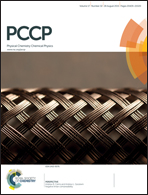Mass partitioning effects in diffusion transport†
Abstract
Frequent mass exchange takes place in a heterogeneous environment among several phases, where mass partitioning may occur at the interface of phases. Analytical and computational methods for diffusion do not usually incorporate molecule partitioning masking the true picture of mass transport. Here we present a computational finite element methodology to calculate diffusion mass transport with a partitioning phenomenon included and the analysis of the effects of partitioning. Our numerical results showed that partitioning controls equilibrated mass distribution as expected from analytical solutions. The experimental validation of mass release from drug-loaded nanoparticles showed that partitioning might even dominate in some cases with respect to diffusion itself. The analysis of diffusion kinetics in the parameter space of partitioning and diffusivity showed that partitioning is an extremely important parameter in systems, where mass diffusivity is fast and that the concentration of nanoparticles can control payload retention inside nanoparticles. The computational and experimental results suggest that partitioning and physiochemical properties of phases play an important, if not crucial, role in diffusion transport and should be included in the studies of mass transport processes.


 Please wait while we load your content...
Please wait while we load your content...